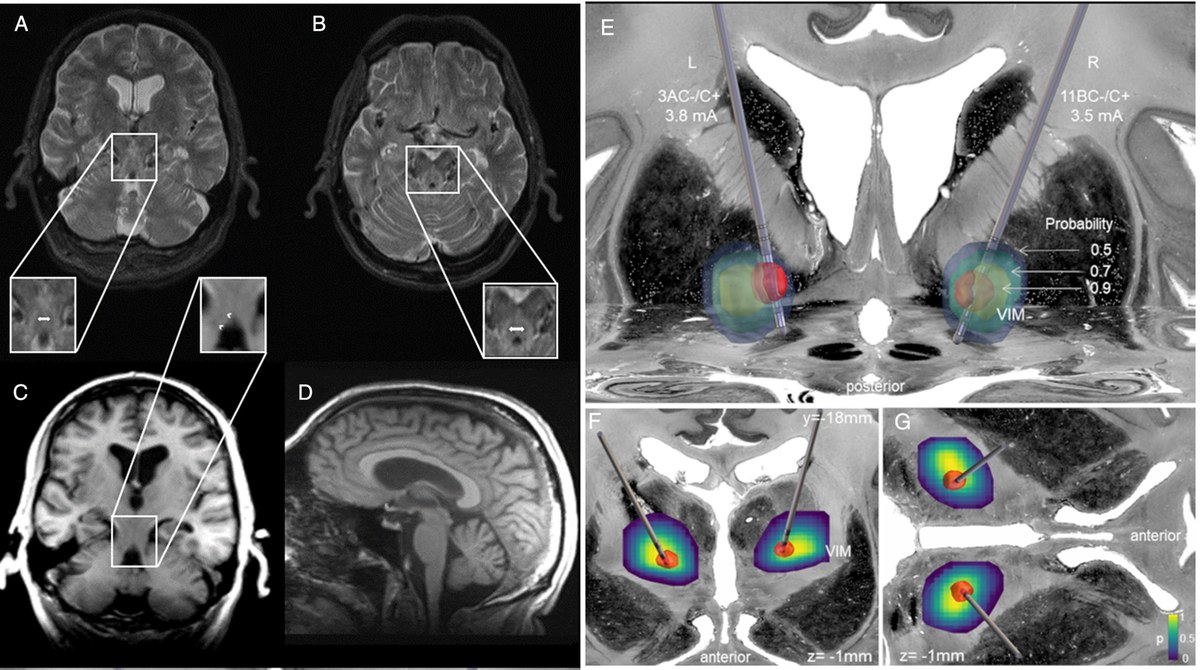Deep brain stimulation proves effective in rare genetic motor disorder
In the journal Movement Disorders Clinical Practice, scientists of the Clinical Neuroanatomy research group at Jülich's INM-1, in cooperation with the Centers for Movement Disorders and Neuromodulation as well as Functional Neurosurgery and Stereotaxy at Düsseldorf University Hospital, have presented a new case report on the effect of deep brain stimulation in a patient with a rare genetic motor disorder. Caused by the mutation of a gene called POLR3A, this disease often results in a pronounced so-called action tremor, which disrupts any voluntary movement of the affected person through severe tremor.
Drug treatment had no effect on the 71-year-old patient, so electrodes were implanted deep in his brain to electrically stimulate a region of the thalamus known as the ventral intermediate nucleus. The therapeutic effect was clear: the trembling of the most affected body parts - head, trunk and arms - was greatly reduced. Everyday activities, such as eating without help or using the computer, were once again possible for the patient. In addition, the improvement was long-lasting: the positive effect continued even five years after the start of treatment.

In a study from 2021, which was available to the researchers, deep brain stimulation was successfully described in only one patient with POLR3A-related disorders, who also suffered from cognitive decline and Parkinsonism. In this case, a different region, the globus pallidus internus, was stimulated. Due to the profound and long-lasting benefit relevant to everyday life, the new study by the researchers from Jülich and Düsseldorf now makes it much clearer that patients suffering from action tremor due to POLR3A mutations can benefit from this therapy.
To visualize the location of the electrodes used in deep brain stimulation, the BigBrain model was used as a background and the Julich-Brain Atlas was used to represent the target region. At the same time, the variability of the brain region could be visualized, as the Julich-Brain Atlas provides three-dimensional probability maps from different mapped brains. This made it easier for the researchers to assess how accurately the electrodes hit their target region.
Originalveröffentlichung:
Minnerop, M., Reinhardt, A., Nikolov, P., Bahners, B.H., Caspers, J., Marae, J.G., Hartmann, C.J., Groiss, S.J., Amunts, K., Vesper, J. and Schnitzler, A. (2025), Long-Term Benefit of Thalamic Deep Brain Stimulation in POLR3A Mutation-Associated Action Tremor. Mov Disord Clin Pract, 12: 882-884. https://doi.org/10.1002/mdc3.70002
Contact
PD Dr. med. Martina Minnerop
Working Group Leader "Clinical Neuroanatomy" and Consultant Neurologist
- Institute of Neurosciences and Medicine (INM)
- Structural and Functional Organisation of the Brain (INM-1)
Room 4013
Press Contact
Erhard Zeiss
Wissenschaftlicher Kommunikationsreferent
- Institute of Neurosciences and Medicine (INM)
- Structural and Functional Organisation of the Brain (INM-1)
Room 3033


